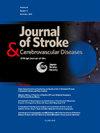淋巴清除功能与脑血管病影像学标志物和危险因素的关系
IF 2
4区 医学
Q3 NEUROSCIENCES
Journal of Stroke & Cerebrovascular Diseases
Pub Date : 2025-02-01
DOI:10.1016/j.jstrokecerebrovasdis.2024.108187
引用次数: 0
摘要
背景:脑血管病(CSVD)是老年人常见病,其发病机制仍在探索中。通过沿血管周围间隙弥散张量成像分析(DTI-ALPS)指数评价淋巴清扫功能。本研究旨在探讨CSVD患者淋巴清除功能的变化及其与影像学标志物和危险因素的关系。方法:计算所有受试者的DTI-ALPS指数。比较患者组与健康对照(hc)组的DTI-ALPS指数。采用Pearson相关分析分析DTI-ALPS指数与CSVD影像学标志物之间的关系,并探讨平均扩散率(MD)作为协变量的影响。采用回归分析探讨DTI-ALPS指数与危险因素的相关性。结果:CSVD患者双侧半球DTI-ALPS指数显著低于hcc组(p < 0.001)。CSVD患者双侧半球DTI-ALPS指数与基底节区EPVS分级呈负相关。左侧DTI-ALPS指数与陷窝呈显著负相关,右侧DTI-ALPS指数与dwmh呈显著负相关。去除协变量MD后,DTI-ALPS指数与CSVD影像学标志物之间无显著相关性。DTI-ALPS指数与性别、糖尿病、饮酒和吸烟有关。结论:CSVD患者存在淋巴清除功能障碍,可能与影像学特征及CSVD危险因素有关。同时,建议考虑将MD作为混合信号去除。本文章由计算机程序翻译,如有差异,请以英文原文为准。
Association of glymphatic clearance function with imaging markers and risk factors of cerebral small vessel disease
Background
Cerebral small vessel disease (CSVD) is a common disease in the elderly, and its pathogenesis is still being explored. Glymphatic clearance function can be evaluated by diffusion tensor imaging analysis along the perivascular space (DTI-ALPS) index. This study aims to investigate the changes in glymphatic clearance function in CSVD patients and its relationship with imaging markers and risk factors of CSVD.
Methods
The DTI-ALPS index of all participants was calculated. The DTI-ALPS index was compared between the patient group and healthy controls (HCs) group. Pearson correlation analysis was used to analyze the relation between the DTI-ALPS index and CSVD imaging markers, and to explore the effect of mean diffusivity (MD) as a covariate. Regression analysis was used to investigate the correlation between DTI-ALPS index and risk factors.
Results
The DTI-ALPS index in the bilateral hemispheres of CSVD patients was significantly lower than that in the HCs group (p < 0.001). The DTI-ALPS index in the bilateral hemisphere of CSVD patients was negatively correlated with the grade of EPVS in basal ganglia. There was a significant negative correlation between the left DTI-ALPS index and lacunas, the right DTI-ALPS index and DWMHs. After removing the covariate MD, there was no significant correlation between the DTI-ALPS index and CSVD imaging markers. The DTI-ALPS index was associated with gender, diabetes, drinking and smoking.
Conclusions
The CSVD patients have glymphatic clearance dysfunction, which may be related to the imaging features and CSVD risk factors. Meanwhile, it's recommended to consider removing MD as mixed signal.
求助全文
通过发布文献求助,成功后即可免费获取论文全文。
去求助
来源期刊

Journal of Stroke & Cerebrovascular Diseases
Medicine-Surgery
CiteScore
5.00
自引率
4.00%
发文量
583
审稿时长
62 days
期刊介绍:
The Journal of Stroke & Cerebrovascular Diseases publishes original papers on basic and clinical science related to the fields of stroke and cerebrovascular diseases. The Journal also features review articles, controversies, methods and technical notes, selected case reports and other original articles of special nature. Its editorial mission is to focus on prevention and repair of cerebrovascular disease. Clinical papers emphasize medical and surgical aspects of stroke, clinical trials and design, epidemiology, stroke care delivery systems and outcomes, imaging sciences and rehabilitation of stroke. The Journal will be of special interest to specialists involved in caring for patients with cerebrovascular disease, including neurologists, neurosurgeons and cardiologists.
 求助内容:
求助内容: 应助结果提醒方式:
应助结果提醒方式:


